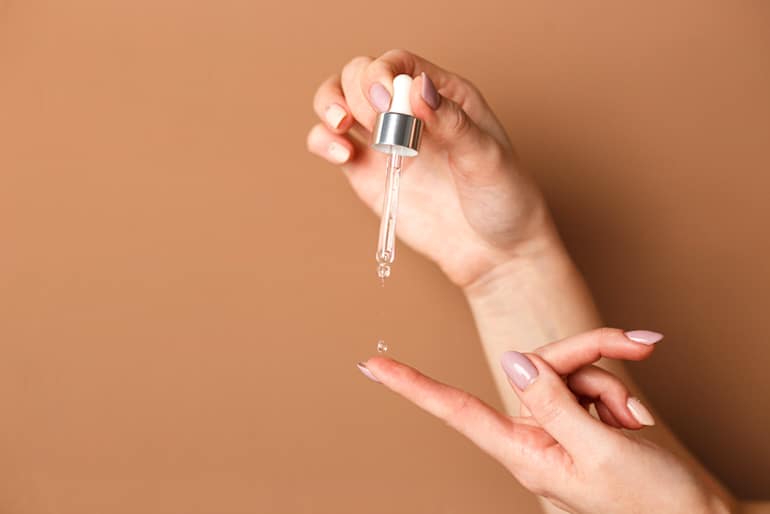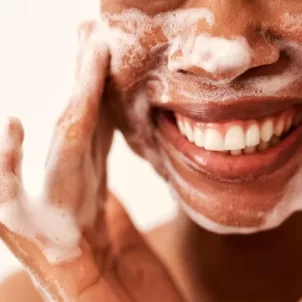Is the PHA skincare trend here to stay? Find out by learning about the benefits of polyhydroxy acid, how it differs from other chemical exfoliants, and how to find the best PHA products for you.
Exfoliants are among the best skincare products to have in your routine. After all, the benefits of exfoliating include but aren’t limited to:



- combatting dullness
- clearing breakouts
- aiding skin cell turnover
What is PHA Skincare?
Polyhydroxy acid (PHA) is a gentle chemical exfoliant. Different types of PHAs include gluconolactone and lactobionic acid. As Xochitl explains, “These acids exfoliate the top layer of dead skin cells by breaking the bonds between them, allowing them to shed more easily.” This process yields such as benefits as:- lighter dark spots
- a brighter complexion
- smoother skin texture

How do they differ from AHA and BHA exfoliants?
Alpha-hydroxy acids (AHAs) and beta-hydroxy acids (BHAs) are well-known in the world of chemical exfoliation. So how do PHAs stack up in comparison?PHA vs. AHA
“PHAs are most chemically and functionally similar to AHAs, such as glycolic acid,” Xochitl explains. (Other types of AHAs include but aren’t limited to lactic acid, malic acid, and mandelic acid.) However, since the molecule size of PHAs is much larger, they’re “more gentle exfoliants since they’re unable to penetrate the skin as deeply.” Because PHAs are best at penetrating the stratum corneum (the skin’s most superficial layer), they’re less likely to cause irritation, sensitivity, and compromised skin barrier function. She shares that AHAs are ideal for normal to dry skin that can tolerate a deeper clean.PHA vs. BHA
Since BHAs are oil-soluble, they’re famed for their power to penetrate pores to help clear breakouts. (Salicylic acid is the most common form of BHA. Additionally, plant-based willow bark extract contains salicin, which itself metabolizes into salicylic acid.) Conversely, as we learned above, PHAs provide more of a surface-level polish. Since BHAs work deep inside the pores to remove excess sebum, Xochitl says that they’re also ideal for oily skin. That said, normal skin types may also enjoy the benefits of exfoliating with BHAs.
What skin types and concerns are best suited for PHA products?
Because of their large molecular structure, polyhydroxy acids are generally safe for most skin types. However, they’re particularly beneficial for people with the following skin types and concerns.Sensitive Skin
Again, since PHAs are gentle, they’re a great chemical exfoliant for sensitive skin that’s prone to reactivity.Dry + Dehydrated Skin
“Since PHAs are humectants, they may also be more hydrating than traditional chemical exfoliants,” Xochitl reiterates. “Therefore, they’re a good alternative for those with drier skin” and bouts of dehydration.Darker Skin Tones
Lastly, hyperpigmentation is a common concern particularly for those with darker skin tones. Fortunately, Xochitl says that PHA skincare is safe and effective for people with melanin-rich skin that may otherwise react to treatments by developing dark spots.How to Add PHA Exfoliants to Your Skincare Routine
Ready to dive into the wonderful world of PHA skincare? Here are some quick tips to get started.1. Choose Your Formulation
PHA products take on a range of forms, including: Ultimately, it’s up to you to choose which one is right for you (or, if you err towards sustainability, which skincare product type you run out of first). However, Xochitl suggests opting for something that sits longer on the skin since “it takes some time for the bonds between the superficial skin cells to be broken.”Best PHA Products
I recommend this PHA toner from Some by Mi. It also includes AHAs, BHAs, and niacinamide, which my combination/hyperpigmentation-prone skin loves. Looking for a gentler PHA toner without additional acids? This budget-conscious option from The Inkey List packs skin-friendly niacinamide and soothing aloe. Otherwise, if you’re more concerned about premature signs of aging, you may want to consider using Herbivore’s Bakuchiol Retinol Alternative Smoothing Serum.
2. Be Cautious of Product Pairings
As we can see, PHAs tend to pair well with other skincare actives. “PHAs are versatile and gentle, making them easier to combine with other active ingredients compared to AHAs and BHAs,” Xochitl shares. However, while they’re most often available as a package deal, it’s important to remember that the ability to tolerate these combos varies from person to person. Similarly, you should be cautious when it comes to pairing PHA skincare with other products in your routine. “I don’t recommend combining vitamin C with PHAs, AHAs, or BHAs,” Xochitl notes, as doing so runs a greater risk of sensitivity. She also flags retinoids for similar reasons. However, this isn’t to say that you should shun these ingredients completely. (Personally, my skin is pretty tolerant and takes well to vitamin C serum layered over my PHA toner.) After all, both topical vitamin C and retinoids can produce incredible benefits for your skin. Instead, you can mix up your regimen by:- using one active in the morning + another at night
- alternating the days on which you apply PHA products, vitamin C + retinoids/retinol
3. Start Slowly
On a final note, you should take a slow and steady approach any time you incorporate a new active ingredient into your skincare routine—and PHA exfoliants are no exception. “Despite their gentleness, PHA is still an acid,” Xochitl reminds us. “I would start low (maybe twice weekly), increase slowly, and proceed” after figuring out the best PHA groove for you.More like this









